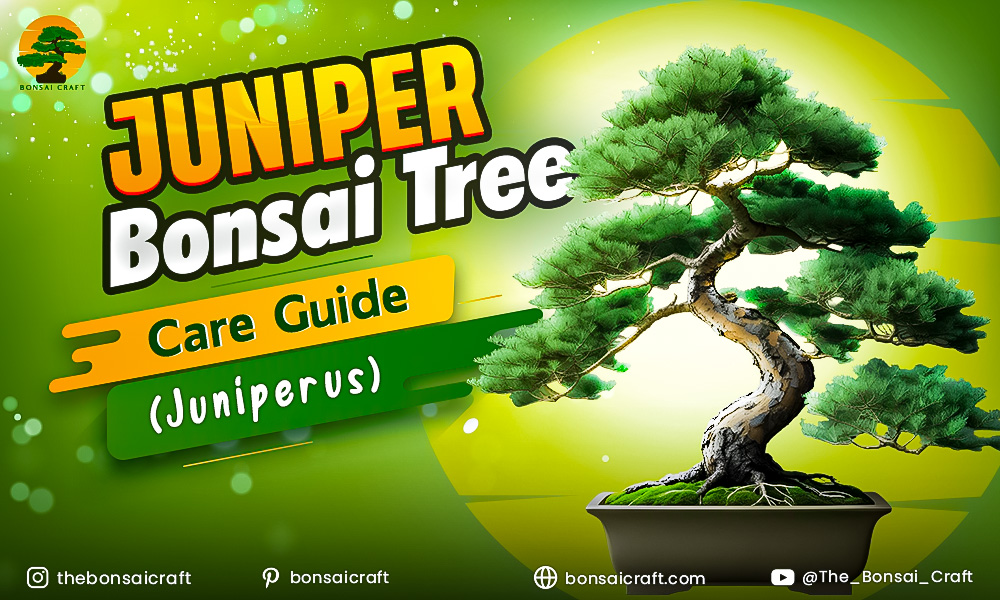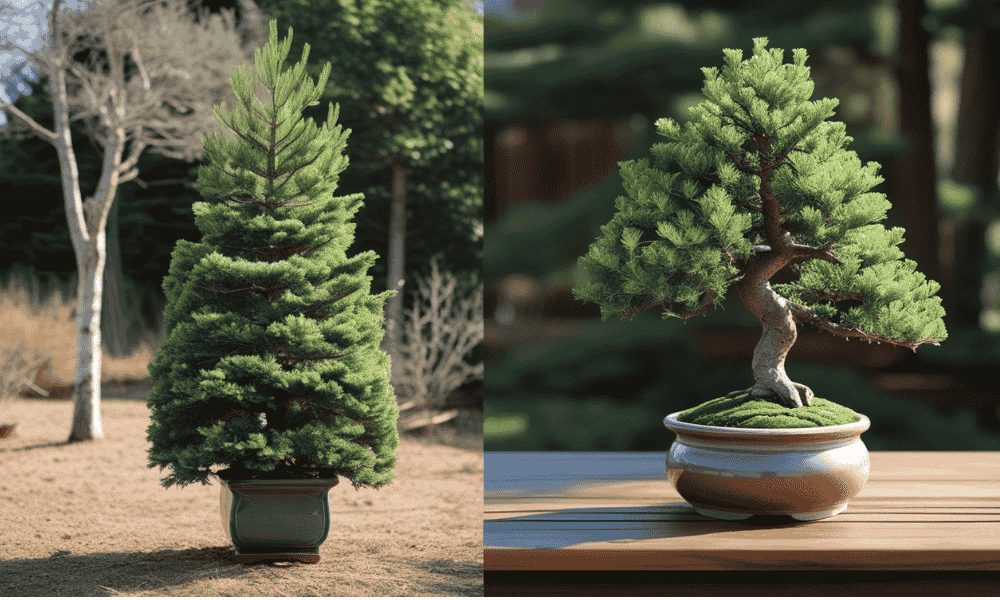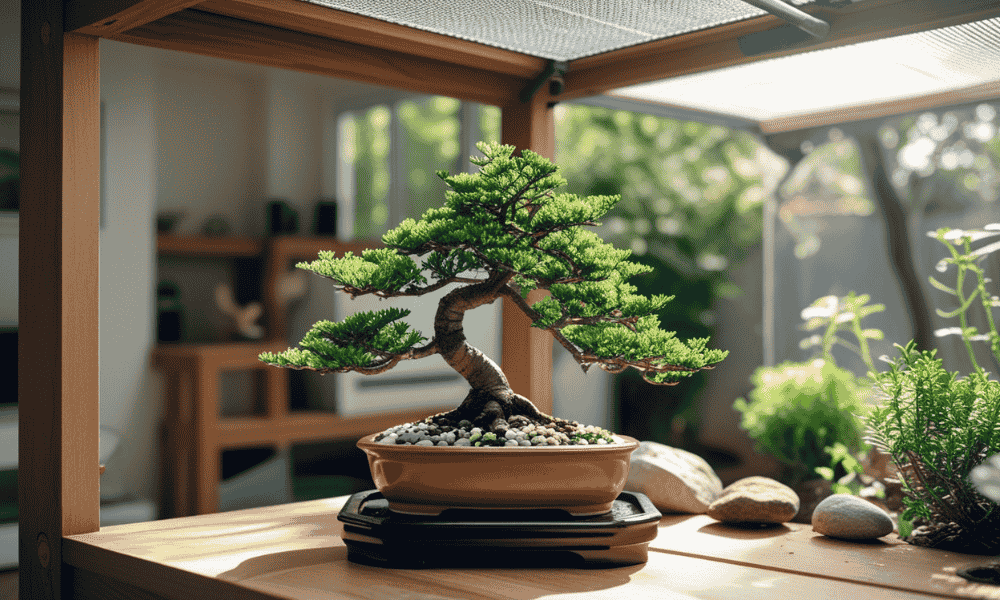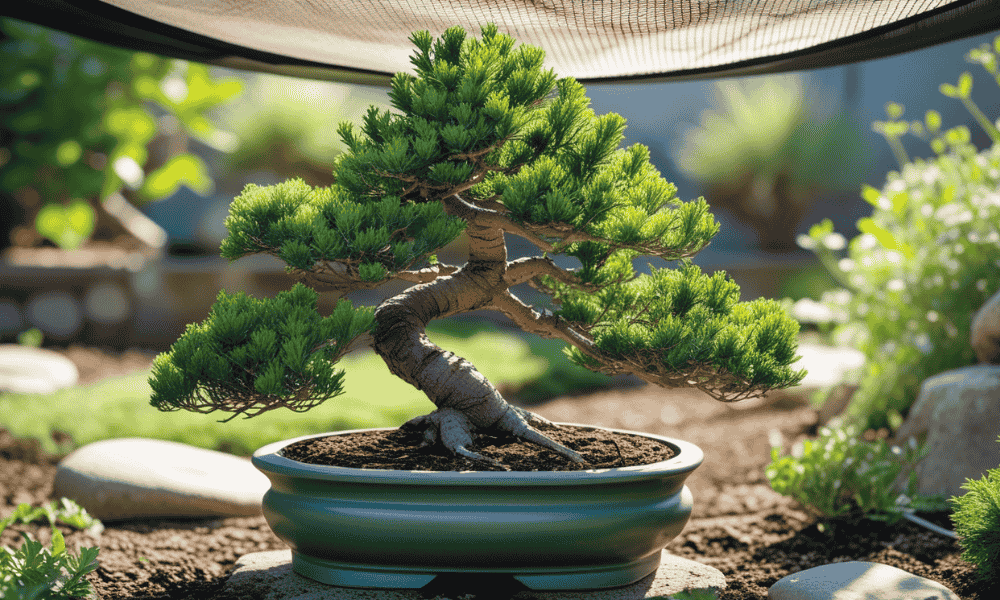
Juniper bonsai tree care easily makes them one of the most favored choices among bonsai enthusiasts. They are versatile thanks to the stunning aesthetic appeal they offer. Add to this care ease, they are evergreens which bring a touch of serenity and beauty, both indoors and outdoors. Nonetheless, like all other bonsai trees, they require specific care needed for them to thrive. Regardless of whether you grow a juniper bonsai indoors or outdoors, thorough management of watering, sunlight, pruning, soil, and attention is pivotal for the health and blooming of the tree.
We will explain everything you need to know about juniper bonsai tree care in all its aspects, including outdoor and indoor tips, pruning and shaping, issue management, and advanced care plans. So, let us explore the juniper bonsai and make sure it will continue to thrive for you for years to come!
What is Juniper Bonsai Tree (Juniperus)?
A juniper bonsai tree is a smaller version of the bigger juniper tree that is to be cultivated using bonsai techniques. The juniper bonsai is an evergreen, which implies that it has needle-like leaves and loses none through the year. This also means it retains a lot of aesthetic value all year round. Its natural toughness and adaptability make this tree a go-to for most bonsai cultivators.
Out of the numerous varieties, the dwarf juniper bonsai tree Care stands out for beginners because of its compact stature and slower growth. These trees can be shaped into upright, cascading, or slanting forms, giving a lot of room for creative styling and placement. In addition, juniper bonsai trees are usually admired for their thick trunks, twisting branches, and rich foliage.
The growing conditions, both indoor and outdoor, are what make juniper bonsai trees unique. As long as they are properly cared for, the trees can withstand various light, temperature, and humidity conditions. This flexibility makes them an ideal choice for bonsai growers.
Why Choose Juniper Bonsai Tree?
Juniper bonsai trees are easy to care for, aesthetically pleasing, and thrive both indoors and outdoors. Their versatility and minimal care requirements make them an ideal choice for bonsai enthusiasts, offering unique styling options with their twisting branches and dense foliage.
There are several reasons why juniper bonsai trees are an excellent choice for bonsai enthusiasts:
Ease of Care: Bonsai novices will find juniper bonsai trees appealing because they’re simple to care for. They don’t require much attention, and relative to other bonsai species, they’re forgiving of occasional mistakes.
Aesthetic Appeal: The combination of the twisting branches and the dense foliage almost makes junipers unnaturally beautiful. These trees can be displayed in various styles like cascading, upright, or slanting.
Versatility: Whether indoors or outdoors, junipers can thrive. Placing them on a windowsill or outside in a garden will allow them to flourish, making them ideal for different growing environments.
Variety: Juniper bonsai trees come in several species, such as the Chinese juniper bonsai and Japanese juniper bonsai, each with its unique characteristics. Whether you’re looking for a hardy tree or one that demands more attention, there is a variety that suits your preference.
Compact Growth: Many juniper bonsai species, particularly the dwarf varieties, have slow growth and compact sizes, making them perfect for smaller spaces. Whether you’re a city dweller or live in a house with limited space, a juniper bonsai tree will fit right in.
Whether you’re looking for an elegant indoor centerpiece or a hardy outdoor bonsai, a juniper bonsai tree fits the bill perfectly.
Best Juniper for Bonsai
The best juniper for bonsai will depend on your environment and care level. Some of the most popular juniper varieties for bonsai include:
- Chinese Juniper Bonsai: Known for its resilience and versatility, the Chinese juniper bonsai is ideal for beginners. It is hardy, adapts well to a variety of growing conditions, and is relatively easy to care for.
- Japanese Juniper Bonsai: The Japanese juniper bonsai is more delicate and requires a bit more care, but its fine foliage and intricate branching patterns make it highly desirable for experienced bonsai growers.
- Dwarf Juniper Bonsai: If you’re looking for a tree that requires less maintenance and has a compact growth habit, the dwarf juniper bonsai tree is the best choice. These trees grow slowly and are perfect for small spaces
How Do You Care for a Juniper Bonsai Tree?
To care for a bonsai juniper tree, ensure it gets 4-6 hours of sunlight daily, water when the soil is dry, and prune regularly. Use well-draining soil and avoid overwatering to prevent root rot. Repot every 2-3 years to refresh the soil.
How Do You Care for a Bonsai Juniper Tree? The bonsai juniper tree for indoor decoration is one of the most popular varieties of bonsai. It features the natural beauty of plants and can be styled into various formations. Though bonsai tree juniper species are predominantly meant for outdoor use, they can also be grown indoors, given sufficient care and dedication.
Juniper trees are naturally suited for the external environment because they require high light and air circulation, but their indoor cultivation has unique requirements. Still, for a lot of fans of such a hobby, these issues concern the latter category of indoor maintenance of their plants, which has the great positives of beautifully sitting in a room and growing a juniper bonsai, which outweighs many negatives.
How To Water Juniper Bonsai Tree
Water the juniper bonsai tree when the top 1-2 inches of soil are dry. Ensure proper drainage by allowing water to flow out of the pot’s bottom. Avoid leaving it in standing water, as it can lead to root rot.
Proper watering is essential for the health and longevity of your juniper bonsai tree. Junipers prefer moist soil, but it’s crucial to avoid overwatering, as this can lead to root rot. On the other hand, underwatering can cause the tree’s leaves to dry out and wither.
- Water the bonsai tree when the top 1 or 2 inches of soil are dry. In warmer weather, this generally means watering every two to three days and less frequently during winter months.
- While watering, make sure to adequately water the tree such that water flows out through the bottom of the pot. This will also help prevent water from pooling in the soil, averting root rot.
- Also, remember, the bonsai tree should not be left in standing water. Make sure the pot has good drainage to stop excessive moisture from gathering at the bottom of the pot.
Signs of Overwatering in Juniper Bonsai: Overwatering can lead to yellowing leaves and soft, mushy roots. Reduce watering frequency and ensure the pot has good drainage to prevent waterlogging and root rot.
Signs of Underwatering in Juniper Bonsai: Underwatering causes dry, brittle leaves and shriveled roots. Water thoroughly, ensuring the soil is evenly moist but not soaked.
Watering Tip:
In summer, junipers might require watering every 2-3 days, while watering during winter should be less as the tree goes into dormancy.
Sunlight Requirements for Juniper Bonsai Trees
Juniper bonsai trees require plenty of sunlight to thrive. If you’re growing a juniper bonsai tree indoors, make sure it gets at least 4–6 hours of bright, indirect sunlight daily. A south-facing window is ideal for this purpose.
Sunlight Requirements for Juniper Bonsai
Indoor juniper bonsai trees require 4-6 hours of bright, indirect sunlight. For outdoor junipers, place them in full sunlight for at least 6 hours daily to encourage healthy growth and vibrant foliage.
- Full Sun: Outdoor junipers should be placed in an area where they can receive full sunlight during the day for at least 6 hours. This is critical to achieving vigorous growth as well as good foliage.
- Avoid Shade: While junipers can tolerate some light shade, they will thrive best when exposed to full sunlight.
Temperature Needs for Juniper Bonsai
Indoor junipers prefer temperatures between 60-75°F (15-24°C). Outdoor junipers can tolerate colder temperatures but need protection from frost during winter to avoid damage.
- Indoor Temperature: Junipers do prefer moderate temperatures. The preferred temperature for indoor juniper bonsai trees to be kept within is 60-75°F (15- 24 °C). Your bonsai needs to be kept away from heat sources like radiators and air conditioners, as these will stress the tree.
- Outdoor Temperature: The hardiest outdoor juniper varieties are capable of surviving lower temperatures. Nonetheless, they require protection from severe frost damage during the winter months.
Temperature Tip:
During colder seasons, it’s important to protect your juniper bonsai from frost, as exposure to freezing temperatures can damage the tree.
Soil for Juniper Bonsai Trees
A good soil mix for juniper bonsai includes akadama, pumice, and lava rock. This ensures proper water retention and good drainage to prevent waterlogging and root rot.
- Akadama (Japanese soil),
- Pumice, and
- Lava rock.
This combination ensures good water retention without becoming waterlogged.
How to Fertilize a Juniper Bonsai?
Fertilize your juniper bonsai with a balanced, slow-release fertilizer every 2-3 weeks during the growing season. In fall and winter, reduce fertilization as the tree enters dormancy.
- When to Fertilize: Use a balanced fertilizer during the growing season (spring to summer) to promote strong growth. A slow-release fertilizer is often recommended for bonsai trees.
- How to Fertilize: Fertilize every 2-3 weeks during the growing season. In the fall and winter, reduce fertilizing, as the tree is in a dormant state and doesn’t require as many nutrients.
Indoor Care for Juniper Bonsai Trees (Juniperus)
Choosing the Right Location for Your Indoor Juniper Bonsai Tree
The location of your indoor juniper bonsai tree is key to its survival. These trees require bright, indirect light and a stable temperature to thrive.
- Optimal Placement: Your indoor juniper bonsai should be placed in a south-facing window or in a well-lit room. Make sure that the tree receives at least 4 to 6 hours of indirect sunlight. In case of insufficient natural light, use sunlight lamps to improve the situation.
- Avoid Drafts: The tabletop bonsai should be kept away from heating vents, air conditioners and cold drafts because these will affect the health of your juniper bonsai, leading to unnecessary stress.
Indoor Care Tip:
In case your indoor setting is dry, placing a humidity tray to help maintain moisture levels for your juniper bonsai will be effective.
How to Care for a Juniper Bonsai Tree Indoors
In caring for an indoor bonsai juniper tree (Juniperus), some factors such as temperature, water management, and humidity should be considered.
- Humidity: Water is essential when it comes to bonsai care. Cold winter months can greatly reduce moisture levels in the air indoors. Surrounding the base of the tree with a humidity tray or lightly spraying the foliage with water will help keep the air moist.
- Temperature: Keep your indoor juniper between 60-75°F (15-24 °C) as the tree goes dormant near 60°F/15°C. Try not to keep it next to heating elements or windows that could scorch the tree.
- Watering: As previously indicated, air indoors tends to be drier, so your juniper is likely to require more frequent watering compared to being outdoors. That said, check the soil moisture regularly, as overwatering can also be a problem.
Winter Care for Indoor Juniper Bonsai Trees
During winter, your indoor juniper bonsai will require some extra care:
- Reduce Watering: Since the tree is entering a semi-dormant phase, it will need less water. Ensure that the soil is not kept too moist during this time.
- Use Grow Lights: To make up for the lack of sunlight, supplement natural light with grow lights to ensure that the juniper stays healthy all through winter.
Outdoor Care for Juniper Bonsai Trees
Caring for Juniper Bonsai Outdoors
Outdoor juniper bonsai trees are relatively low-maintenance but do require proper placement and care:
- Full Sun: Make sure that your outdoor juniper bonsai is kept in an area that receives upwards of 6 hours of direct sunlight daily.
- Watering: Compared to indoor bonsai trees, outdoor bonsai trees tend to require more frequent watering, especially during the summer months when evaporation is at its peak.
Outdoor Care Tip:
If you live in an extremely hot climate, consider providing some afternoon shade to prevent your juniper bonsai from drying out too quickly.
Winterizing Outdoor Juniper Bonsai Trees
If you live in an area with cold winters, it’s important to winterize your outdoor juniper bonsai:
- Frost Protection: Cover the tree with a breathable cloth or place it in a sheltered location during extreme cold to protect it from frost damage.
Temperature Considerations: While junipers can tolerate colder temperatures, make sure the tree is shielded from freezing conditions to prevent damage.
Shaping and Pruning Your Juniper Bonsai Tree
Pruning Juniper Bonsai Trees
Prune your juniper bonsai by removing dead or damaged branches and pinching back new growth to encourage more branching. Regular pruning maintains shape and promotes healthy growth. Proper pruning encourages healthy growth and helps maintain the tree’s shape:
- Remove Dead Branches: Always prune dead, diseased, or damaged branches to keep your tree healthy.
- Pinching New Growth: Pinch back the tips of new growth to encourage more branching and a fuller tree.
Pruning Tip:
Prune your juniper bonsai during the growing season to encourage strong, healthy growth and a well-balanced shape.
Advanced Shaping Tips
As you become more experienced with your juniper bonsai tree, you can experiment with advanced shaping techniques:
- Wiring: Take advantage of the wire to achieve your intended design by changing the position of the branches. Junipers respond exceptionally to wiring, and a great many shapes can be created.
- Encouraging Growth: Growth: Lowering the number of leaves and keeping them is beneficial and helps to decrease dense foliage while also helping maintain the vigor of the tree.
Common Issues with Juniper Bonsai Trees
Common issues include yellowing leaves, pests (spider mites, aphids), and stunted growth. Adjust watering, light, and humidity levels to address these issues.
Yellowing Leaves and Drooping
Yellowing or drooping leaves can be a sign of several issues:
- Overwatering: If the leaves turn yellow and the roots become soft, overwatering might be the issue. Reduce watering and ensure the soil has good drainage.
- Underwatering: If the leaves are dry and brittle, the tree might be underwatered. Ensure the soil is consistently moist but not soaked.
Pests and Diseases
Juniper bonsai trees are susceptible to pests like spider mites, aphids, and scale insects:
- Spider Mites: Look for fine webbing or tiny, discolored spots on the leaves. Treat with insecticidal soap or neem oil.
- Scale Insects: These small, round pests can be scraped off manually or treated with a pesticide.
Advanced Care and Propagation of Juniper Bonsai Trees
Repotting Your Juniper Bonsai Tree
Your Juniper bonsai needs repotting after two to three years, or else it will not have sufficient space for the roots. While doing so, ensure you use a soil mix that drains well, then prune the roots to keep the size of the tree constant.
How to Propagate Juniper Bonsai Trees
To propagate your juniper bonsai tree, you can capture cuttings from succulent branches. Place the cuttings in moistened media that drains easily until roots develop.
Conclusion
Caring for a juniper bonsai tree (Juniperus) is both an art and a science. By following these tips for watering, sunlight, pruning, and troubleshooting, your juniper bonsai tree can thrive and become a beautiful addition to your home or garden. Whether you grow it indoors or outdoors, understanding the unique needs of juniper bonsai will ensure your tree stays healthy and vibrant for years to come.
Whether you are a beginner or an experienced bonsai enthusiast, careful attention to your juniper bonsai care routine ensures healthy growth and longevity. With proper efforts, an indoor juniper bonsai tree can flourish throughout all seasons, enhancing the beauty of any indoor space.
FAQs About Juniper Bonsai Care
How to care for a Juniper bonsai tree?
Place your Juniper bonsai in a sunny spot with at least 4–6 hours of direct light daily. Water it when the soil feels slightly dry, avoid overwatering, prune regularly to maintain its shape, and fertilize during the growing season.
How often to water a Juniper bonsai?
Water your Juniper bonsai when the top layer of soil begins to dry. Typically, this means watering every 2–3 days in summer and less often in winter. Always check soil moisture before watering.
How to prune a Juniper bonsai?
Prune new shoots with sharp scissors or by pinching them back with your fingers. Remove crossing or weak branches and shape the bonsai gradually. Avoid heavy pruning during the growing season.
When should I repot my Juniper bonsai?
Repot every 2–3 years in early spring before new growth starts. Use well-draining bonsai soil and trim up to one-third of the roots to encourage healthy growth.
Why is my Juniper bonsai turning brown?
Browning may be caused by overwatering, underwatering, poor drainage, pests, or lack of sunlight. Check soil moisture, ensure proper airflow, and treat pests if visible.
How long do Juniper bonsai trees live?
With proper care, Juniper bonsai trees can live for decades, often 30–50 years or more. Some well-maintained bonsai have been known to live for over 100 years.



